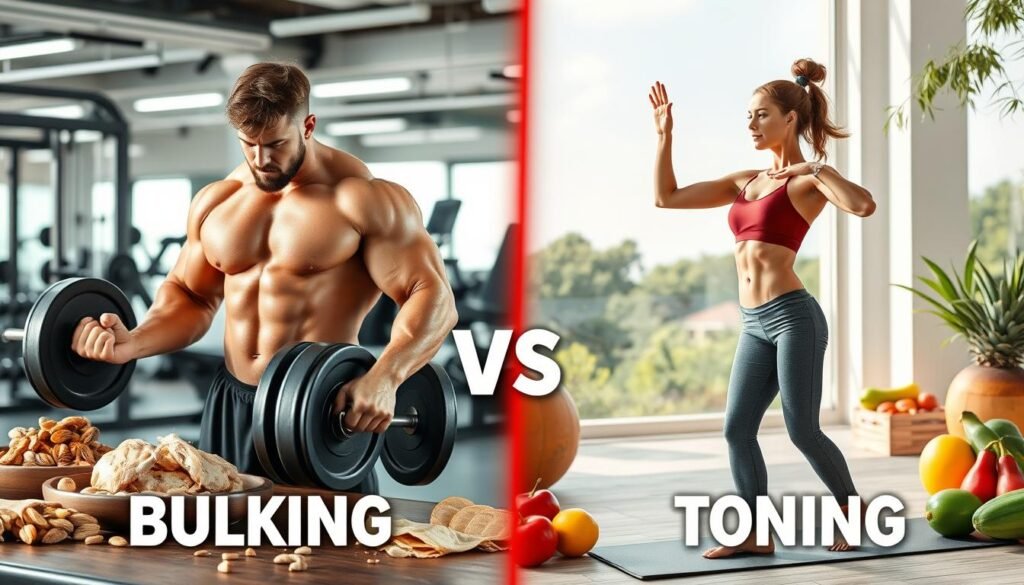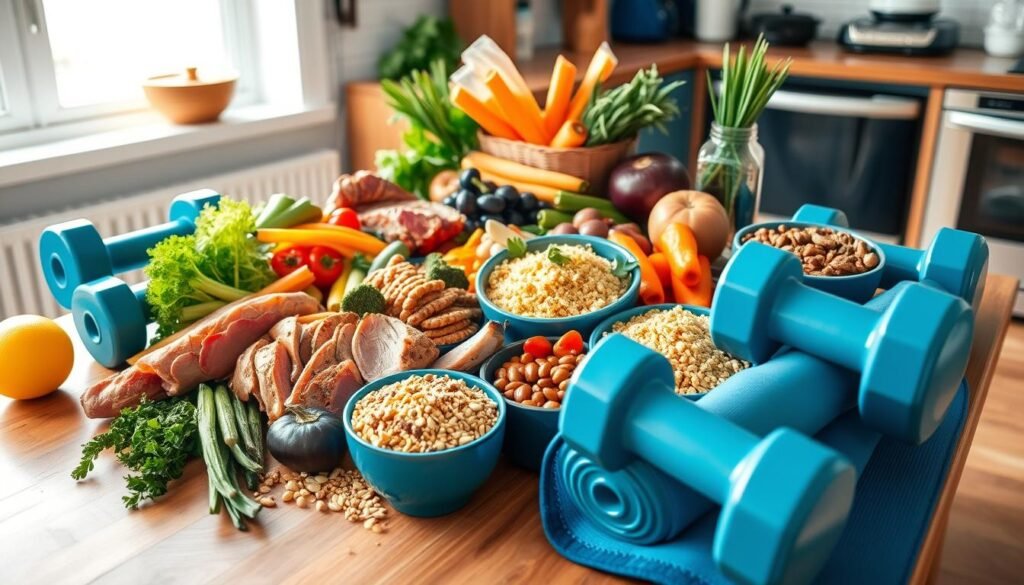Did you know people often gain about 15-20 lbs of muscle in a good bulking cycle? But, they might also gain around 5 lbs of fat. This highlights the differences between bulking and toning. Both are key to creating your dream body. Knowing about these can really help you meet your fitness goals. It’s vital for anyone wanting to change how their body looks.
Want to know how bulking and toning strategies can be made just for you? This article talks about that. Whether you want more muscle or just to tight and tone, understanding bulking vs toning is key. You’ll find top bodybuilding tips here. They will guide you on your fitness journey. It’ll also show you how important eating right and working out are.
Key Takeaways
- Effective bulking can yield 15-20 lbs of muscle with some fat gain.
- Understanding personal fitness goals is essential for a successful transformation.
- Tailored dietary and exercise strategies are crucial for different body types.
- Recognizing the differences in bulking vs toning can optimize results.
- Proper nutrition aids in preventing injuries and setbacks during the bulking phase, remember to explore these tips.
Understanding Bulking and Toning
Bulking and toning are vital concepts for starting fitness journeys. While bulking involves eating more for muscle growth, it also needs strength training. The aim is to gain muscle without adding too much fat.
Toning, on the other hand, focuses on losing fat to make muscles more visible. It usually means eating less and working out more. Some people, especially women, worry that lifting weights will make them too bulky. They are often concerned about gaining too much muscle.
For better toning, exercising with heavier weights in the 8 to 12 rep range is effective. The belief that light weights and many reps are enough can be wrong. A mix of strength training and cardio gives the best toning results.
Knowing about bulking and toning can help create workouts that meet personal goals. It encourages a commitment to exercise that improves health and body shape. By clearing up common fitness myths, people can work towards their goals more confidently.
Defining Your Body Goals
Setting specific body goals is crucial on your fitness path. Knowing your targets shapes your diet and exercise routines. People aim for various outcomes, like gaining muscle or getting lean. Defining what’s important to you is the first step towards success.
Knowing where you stand fitness-wise is key to planning. If you want to gain muscle, expect some fat too. Bulking up means eating more, with protein intake suggested at 1.8-2.0 grams per kilogram of your weight. You should lift heavier but do fewer reps. This helps muscles grow better. Aim to lift weights 3 to 6 times a week, doing 4 to 6 heavy sets each time.
If you’re looking to tone, it’s about showing muscles and cutting fat. Toning requires both resistance workouts and cardio. Keep calories around what you need or less. Protein is vital to keep muscle while reaching your goal. Eating 30% fats, 45% carbs, and 25% protein is a balanced approach for this aim.
Muscle Gain vs Fat Loss: The Basics
To create your ideal body, you should grasp the basics of gaining muscle and losing fat. For muscle gain, a person needs more calories than usual. This means eating 10-20% more calories. A 175-pound man might need 250–500 extra calories every day during a muscle-building phase. Meanwhile, a 135-pound woman could add 200–400 calories daily to grow muscle.
In terms of protein, bulking fundamentals suggest consuming 0.7–1 gram per pound of body weight. Aim to increase weight by 0.25–0.5% of total body weight weekly. This helps ensure mostly muscle is gained. An active male generally needs about 2,600 calories daily to keep his current weight. An active female usually needs about 2,000 calories.
For fat loss, the idea is to eat less. You should eat 500 calories less than your maintenance level. This approach often leads to losing about 1 pound (0.45 kg) every week. To keep muscle while losing fat, your protein needs might increase to 0.6–1.4 grams per pound of body weight. It’s safe to aim for losing 0.5–1% of your body weight per week.
Bulking and cutting have their own results. Bulking might add some fat, and cutting could reduce muscle mass too. It’s crucial to combine weight lifting with cardio for effective results. A balanced plan helps improve body composition. Tailoring your exercise and diet plan to your personal goals is important.
Bulking vs Toning: Key Differences
Understanding the bulking vs toning differences is essential. Bulking means aiming to gain more muscle through heavy weights and more food, usually adding 250-500 extra calories a day. This method involves doing a few reps, about 4-8, in each set. The goal is to grow bigger muscles.
Toning, on the other hand, focuses on getting muscle definition and losing fat. It includes doing many reps with lighter weights, usually 15-20 in each set. To tone, you need to eat less than your body uses, creating a caloric deficit but still eating enough protein to keep muscles strong.
The effort needed for bulking and toning varies a lot. Becoming a bodybuilder requires lots of time, around 20-30 hours of intense training each week. What you eat is also key. Bulking up means eating more carbs, while toning means watching your overall calories but focusing on losing fat.
Using the right workout gear can help with either goal. A good exercise plan includes different tools to help with various types of strength exercises. Interestingly, about 70% of women in gyms want to tone up without getting bulky.
Muscle is denser than fat, making a big difference in how you look. Gaining muscle and losing fat can make you appear leaner. Strength training not only changes your body’s look but also boosts your metabolism. This helps maintain a good fitness routine, whether you’re bulking or toning.

Learning about specific fitness plans can be useful. For advice on setting realistic bulking goals, click here. Tailored fitness strategies can lead to better results, fitting your unique body type and goals.
Effective Weightlifting Strategies
Weightlifting strategies are key to reaching your fitness goals, whether you want to get big or get lean. It’s important to know which exercises work best for you. This ensures your body reacts well to your workouts. Different strength training methods can be better for different people’s needs.
Choosing the Right Exercises
Choosing the right exercises is crucial for your fitness journey. For toning, include exercises like:
- Squats
- Push-ups
- Deadlifts
- Bench presses
- Resistance band workouts
These exercises boost muscle endurance and help define your body. But if you want to build muscle, go for heavier weights and fewer reps. This technique encourages muscle growth, leading to bulk. Mix high-rep exercises for toning with heavy lifting for building muscle for best results.
Combining Strength Training Techniques
Using different strength training methods can lead to better results. Progressive overload means slowly upping the weight you lift, which helps muscles grow over time. Periodization involves changing your training plan to avoid plateaus, keeping your progress steady. For toning, eat fewer calories and add cardio, like running or biking. This helps burn fat while keeping your metabolism and muscle shape.
For more tips on weightlifting for women, including how to lift weights without bulking up, check out this resource.
Nutrition for Muscle Gain
Nutrition is key to gaining muscle. A good diet must aid muscle repair and growth. It should focus on protein, carbohydrates, and fats. These macronutrients are essential for muscle success.
Importance of Protein Intake
Protein is vital for muscle gain. It repairs and builds muscle after workouts. You should eat 1.6 to 2.2 grams of protein per kilogram of your weight daily, based on how active you are. Good protein sources are chicken, turkey, fish, eggs, and plants like beans.
Prioritizing protein helps with recovery and muscle growth.
Balancing Carbs and Fats
Balancing carbs and fats is also crucial. Carbs give you energy for workouts. They should be a big part of your diet. Meanwhile, healthy fats help with hormones and health. Foods like avocados, nuts, and olive oil are great.
A balanced diet supports muscle growth and provides energy for performance and recovery.

| Macronutrient | Recommended Daily Intake | Sources |
|---|---|---|
| Protein | 1.6 – 2.2 g/kg body weight | Chicken, Turkey, Fish, Eggs, Legumes |
| Carbohydrates | 45-60% of total calories | Rice, Pasta, Fruits, Vegetables |
| Fats | 20-35% of total calories | Nuts, Seeds, Avocados, Olive Oil |
Nutrition for Toning
Getting a toned body isn’t just about working out. What you eat is key. To tone up, you need to eat right and keep a caloric deficit. This means eating healthy to lose fat but keep muscle.
Caloric Deficit: What You Need to Know
To tone, you need to eat less calories than you burn. This is called a caloric deficit. Aim for a 500 calorie deficit each day for healthy weight loss. This could lead to losing about 1 pound each week.
For toning, men should eat between 1,500 to 1,800 calories a day. Women should eat between 1,200 to 1,500 calories. This helps you lose weight without losing muscle.
The Role of Healthy Eating Habits
Eating right is vital for toning. Important tips include:
- Whole foods: Choose fruits, veggies, lean proteins, and whole grains for better nutrition.
- Portion control: Keep an eye on portion sizes to manage calories without feeling hungry.
- Hydration: Drink lots of water to help your metabolism and feel less hungry.
With these tips, you can achieve your toning goals and enjoy tasty, healthy meals.
| Aspect | Details |
|---|---|
| Caloric Deficit | Daily deficit of 500 calories recommended |
| Recommended Intake for Men | 1,500 to 1,800 calories per day |
| Recommended Intake for Women | 1,200 to 1,500 calories per day |
| Key Nutrient Focus | Protein intake of 1.0 to 1.5 grams per kilogram of body weight |
| Healthy Eating Habits | Whole foods, portion control, hydration |
Workout Routines for Bulking
To bulk up effectively, you need a smart plan that includes strength training. A good program focuses on big movements, the right number of reps, and how often you workout. These help you gain muscle the right way.
Designing a Balanced Training Program
A balanced program is key for more muscle. It should have:
- Compound exercises: These work many muscles and joints at once for bigger gains. Think squats, deadlifts, and bench presses.
- Rep ranges: For growing muscles, do 8 to 12 reps. This is perfect for making muscles bigger and stronger.
- Frequency: Workout each muscle group 2 to 3 times a week. This gives muscles time to grow and recover.
This approach helps build muscles well. It also boosts endurance and strength. And since over 70% of people say lifting heavy is key for muscle, it’s important to lift the right amount for you.
Tracking Your Progress Effectively
When bulking, it’s vital to track your progress. This lets you see what’s working and change what’s not. Here’s how to track it:
| Metric | Description | Recommended Frequency |
|---|---|---|
| Body Weight | Check your weight weekly to spot trends. | Weekly |
| Measurements | Measure parts like chest, waist, arms to see growth. | Bi-weekly |
| Strength Gains | Note down weights lifted every workout for progress. | Every session |
By tracking these points, you keep an eye on your bulking goal. Spotting changes early helps you tweak and improve your plan for better results.
Workout Routines for Toning
To get a toned body, you need workouts that focus on both strength and endurance. This part talks about the perks of high-rep sets in your routines. It also shares handy exercises to do at home, fitting easily into a busy day.
Incorporating High-Rep Sets
High-rep sets are key for toning, helping you increase muscle endurance and look more defined. Aim for 8 to 15 reps in each set to target muscles without bulking up. This method involves lifting weights that are tough yet manageable for endurance. Adding high-rep sets to your routine boosts muscle stamina and triggers fat loss, giving you a look many admire.
At-Home Exercises for Toning
If you prefer working out at home, there are plenty of exercises that help tone muscles without gym gear. Bodyweight moves like:
- Squats
- Lunges
- Plank variations
- Burpees
- Leg raises
You can do these exercises anywhere for a solid workout. Keeping up with them regularly can lead to great results. Mixing cardio with strength exercises further enhances toning. For top tips on muscle-toning moves, you can check out this guide.
Body Recomposition: A Mixed Approach
Body recomposition offers a unique path for gaining muscle and losing fat all at once. It advises a slight caloric deficit and emphasizes eating a lot of high-quality protein. This helps change body composition smoothly without huge shifts in weight.
Understanding how much protein your body needs is vital for success. About 0.64 grams of protein per pound of body weight helps maintain muscle during fat loss. This is especially useful for those with more body fat or beginners in fitness.
Body recomposition is different from just bulking up or slimming down. It allows for gradual, sustainable body changes. You can slowly improve muscle definition over time, potentially increasing muscle mass by 1-2% monthly.
Strength training is critical in this plan. Regular lifting helps keep muscles while shedding fat. But, avoiding big cuts in calories is important to keep from losing muscle. This makes the right nutrition crucial.

- Keep calories low but eat lots of proteins.
- Spread out your protein meals, every 3 to 4 hours.
- Do strength training 3-4 days a week.
- Stay patient, as both muscle gain and fat loss take time.
For those looking for a balanced way to get fit, body recomposition is a great method. It focuses on gaining muscles and losing fat together. This approach helps improve how you look, avoiding extreme diets or workouts.
| Strategy | Pros | Cons |
|---|---|---|
| Body Recomposition | Simultaneous muscle gain and fat loss, sustainable changes | Slower progress compared to bulking |
| Bulking | Rapid muscle gain, increased strength | Potential fat gain, harder to maintain caloric surplus |
| Cuts | Quick fat loss, clear results | Muscle mass loss without careful management |
Conclusion
Looking into the bulking and toning summary shows the differences between these fitness methods. Each requires its own strategy, matching individual goals. This could be gaining muscle or getting a defined body.
It’s not just the workouts that matter for your dream body, but also what you eat. Bulking or toning, you need a mix of good training and the right food. Eating enough protein is key for muscle recovery and growth. Also, tips from achieving a toned physique highlight the need for patience and constant effort.
The secret to fitness success is knowing your body and what you aim to achieve. By mixing the proper exercises, diet, and dedication, you can reach your fitness goals. Whether it’s bulking up or getting toned, the right approach will get you there.